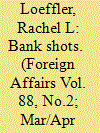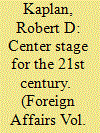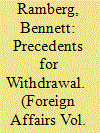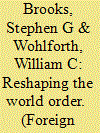|
|
|
Sort Order |
|
|
|
Items / Page
|
|
|
|
|
|
|
| Srl | Item |
| 1 |
ID:
086028


|
|
|
|
|
| Publication |
2009.
|
| Summary/Abstract |
Over the last five years, U.S. national security policy and the international banking system have become inextricably intertwined. With terrorism and nuclear proliferation at the top of the United States' foreign policy agenda and few diplomatic or military levers left to pull, Washington has increasingly turned to the private sector for help in confronting some of its biggest international challenges. That has meant, above all, an effort to work with banks to put pressure on states and other international actors that the United States otherwise has little ability to influence.
This effort is defined by a careful dance between the U.S. government and the global banking industry. Through targeted financial measures, Washington has signaled to banks situations in which it sees dangerous actors intersecting with the international financial system. Banks, for the most part, have acted on these signals, and the two most recent chapters in this unfolding story -- Iran and North Korea -- suggest that using global finance to shape the behavior of international actors can be remarkably powerful.
But financial measures are only as effective as the banks that implement them. Given the role that banks, rather than governments, now play as agents of international isolation, policymakers must develop a more sophisticated and accurate understanding of what this new tool of statecraft can and cannot do. In its bid to curb Iran's and North Korea's destabilizing efforts to develop or expand their nuclear programs, the U.S. government has, in recent years, financially targeted not only Tehran and Pyongyang but also the individuals, companies, and associations that front their illicit activities. These measures have depended on a diplomatic campaign aimed at the world's financial centers
|
|
|
|
|
|
|
|
|
|
|
|
|
|
|
|
| 2 |
ID:
086029


|
|
|
|
|
| Publication |
2009.
|
| Summary/Abstract |
Theary Seng often thinks of that April morning in 1975 when she watched her parents cheering on the Khmer Rouge as its soldiers marched into Phnom Penh. She was four years old. Within days, Pol Pot's foot soldiers had killed her father; three years after that, her mother died in a prison compound. Today, Theary Seng runs a nonprofit legal-advocacy group in Phnom Penh. She is eager to move on. But the rest of Cambodia, and much of the world, remains mired in the nation's sorrowful past. During its four-year reign, the Khmer Rouge killed as many as two million people. Nowadays, the venal government of Prime Minister Hun Sen may take "ten lives or even a hundred lives," she told me in August, "but what's that compared to two million? That's still the Cambodian standard, and that's the international standard." The devastation Pol Pot wreaked on his country remains hard to comprehend, even three decades later. His goal, as he put it, was to return Cambodia to "year zero" and transform it into an agrarian utopia. To that end, he purged his nation of educated city dwellers, monks, and minorities, while imposing a draconian resettlement program that uprooted almost everyone else. These measures led to the deaths of one-quarter of the country's population. The Khmer Rouge fell in 1979, when Vietnam invaded Cambodia and replaced the regime with a puppet government, in which Hun Sen became the foreign minister. When Vietnamese forces pulled out ten years later, they left behind several Cambodian factions battling for control. Then, in 1991, these groups' leaders signed a UN-sponsored peace accord, giving Cambodia the extraordinary opportunity to start over. Before Iraq, Afghanistan, Somalia, and even the Balkans, Cambodia was the international community's grand nation-building project. The country's new constitution awarded Cambodians the human rights, personal freedoms, and other protections of a modern democratic state. And in 1993, the United Nations staged a national election to select a democratic government. After the horrors of the Khmer Rouge, Cambodia would remake itself at last, and its people would have a chance to thrive.
|
|
|
|
|
|
|
|
|
|
|
|
|
|
|
|
| 3 |
ID:
086022


|
|
|
|
|
| Publication |
2009.
|
| Summary/Abstract |
For better or worse, phrases such "the Cold War" and "the clash of civilizations" matter. In a similar way, so do maps. The right map can stimulate foresight by providing a spatial view of critical trends in world politics. Understanding the map of Europe was essential to understanding the twentieth century. Although recent technological advances and economic integration have encouraged global thinking, some places continue to count more than others. And in some of those, such as Iraq and Pakistan, two countries with inherently artificial contours, politics is still at the mercy of geography.So in what quarter of the earth today can one best glimpse the future? Because of their own geographic circumstances, Americans, in particular, continue to concentrate on the Atlantic and Pacific Oceans. World War II and the Cold War shaped this outlook: Nazi Germany, imperial Japan, the Soviet Union, and communist China were all oriented toward one of these two oceans. The bias is even embedded in mapping conventions: Mercator projections tend to place the Western Hemisphere in the middle of the map, splitting the Indian Ocean at its far edges. And yet, as the pirate activity off the coast of Somalia and the terrorist carnage in Mumbai last fall suggest, the Indian Ocean -- the world's third-largest body of water -- already forms center stage for the challenges of the twenty-first century. The greater Indian Ocean region encompasses the entire arc of Islam, from the Sahara Desert to the Indonesian archipelago. Although the Arabs and the Persians are known to Westerners primarily as desert peoples, they have also been great seafarers. In the Middle Ages, they sailed from Arabia to China; proselytizing along the way, they spread their faith through sea-based commerce. Today, the western reaches of the Indian Ocean include the tinderboxes of Somalia, Yemen, Iran, and Pakistan -- constituting a network of dynamic trade as well as a network of global terrorism, piracy, and drug smuggling. Hundreds of millions of Muslims -- the legacy of those medieval conversions -- live along the Indian Ocean's eastern edges, in India and Bangladesh, Malaysia and Indonesia.
|
|
|
|
|
|
|
|
|
|
|
|
|
|
|
|
| 4 |
ID:
086026


|
|
|
|
|
| Publication |
2009.
|
| Summary/Abstract |
As the twentieth century drew to an end, it became clear that a major change was taking place in the countries of the Arab world. For almost 200 years, those lands had been ruled and dominated by European powers and before that by non-Arab Muslim regimes -- chiefly the Ottoman Empire. After the departure of the last imperial rulers, the Arab world became a political battleground between the United States and the Soviet Union during the Cold War. That, too, ended with the collapse of the Soviet Union in 1991. Arab governments and Arab dynasties (royal or presidential) began taking over. Arab governments and, to a limited but growing extent, the Arab peoples were at last able to confront their own problems and compelled to accept responsibility for dealing with them.Europe, long the primary source of interference and domination, no longer plays any significant role in the affairs of the Arab world. Given the enormous oil wealth enjoyed by some Arab rulers and the large and growing Arab and Muslim population in Europe, the key question today is, what role will Arabs play in European affairs? With the breakup of the Soviet Union, Russia ceased to be a major factor in the Arab world. But because of its proximity, its resources, and its large Muslim population, Russia cannot afford to disregard the Middle East. Nor can the Middle East afford to disregard Russia.The United States, unlike Europe, has continued to play a central role in the Arab world. During the Cold War, the United States' interest in the region lay chiefly in countering the growing Soviet influence, such as in Egypt and Syria. Since the end of the Cold War, U.S. troops have appeared occasionally in the region, either as part of joint peace missions (as in Lebanon in 1982-83) or to rescue or protect Arab governments from their neighboring enemies (as in Kuwait and Saudi Arabia in 1990-91). But many in the Arab world -- and in the broader Islamic world -- have seen these activities as blatant U.S. imperialism. According to this perception, the United States is simply the successor to the now-defunct French, British, and Soviet empires and their various Christian predecessors, carrying out yet another infidel effort to dominate the Islamic world.
|
|
|
|
|
|
|
|
|
|
|
|
|
|
|
|
| 5 |
ID:
086025


|
|
|
|
|
| Publication |
2009.
|
| Summary/Abstract |
Each year, the effects of climate change are coming into sharper focus. Barely a month goes by without some fresh bad news: ice sheets and glaciers are melting faster than expected, sea levels are rising more rapidly than ever in recorded history, plants are blooming earlier in the spring, water supplies and habitats are in danger, birds are being forced to find new migratory patterns.The odds that the global climate will reach a dangerous tipping point are increasing. Over the course of the twenty-first century, key ocean currents, such as the Gulf Stream, could shift radically, and thawing permafrost could release huge amounts of additional greenhouse gases into the atmosphere. Such scenarios, although still remote, would dramatically accelerate and compound the consequences of global warming. Scientists are taking these doomsday scenarios seriously because the steady accumulation of warming gases in the atmosphere is forcing change in the climate system at rates so rapid that the outcomes are extremely difficult to predict.Eliminating all the risks of climate change is impossible because carbon dioxide emissions, the chief human contribution to global warming, are unlike conventional air pollutants, which stay in the atmosphere for only hours or days. Once carbon dioxide enters the atmosphere, much of it remains for over a hundred years. Emissions from anywhere on the planet contribute to the global problem, and once headed in the wrong direction, the climate system is slow to respond to attempts at reversal. As with a bathtub that has a large faucet and a small drain, the only practical way to lower the level is by dramatically cutting the inflow. Holding global warming steady at its current rate would require a worldwide 60-80 percent cut in emissions, and it would still take decades for the atmospheric concentration of carbon dioxide to stabilize.
|
|
|
|
|
|
|
|
|
|
|
|
|
|
|
|
| 6 |
ID:
086027


|
|
|
|
|
| Publication |
2009.
|
| Summary/Abstract |
Last July, more than 200,000 people flocked to a public park in Berlin to hear Barack Obama, then the Democratic candidate for president of the United States, deliver a speech calling for renewed transatlantic partnership and cooperation. The choice of Germany's long-divided capital as the backdrop for his only public speech in Europe was deliberate. To the Germans listening to him that summer evening in the Tiergarten, Obama made a special appeal, citing "a set of ideals that speak to aspirations shared by all people," the same "dream of freedom" that was the basis of the relationship between the United States and West Germany during the Cold War. Now that Obama is president, will Germany respond to the call and join the United States as a key European partner in addressing global challenges and threats?There are many reasons for Germany to rise to the occasion. For one, there is a dearth of leadership elsewhere in Europe. The European Union remains embroiled in a debate about institutional reform. In the United Kingdom, Prime Minister Gordon Brown -- despite his confidence during the current financial crisis -- remains disengaged from both the EU and the transatlantic alliance. French President Nicolas Sarkozy, meanwhile, shows more Atlanticist inclinations than any of his predecessors, but he has yet to prove that he can build lasting coalitions in Europe or convince his country of the need for economic modernization.
|
|
|
|
|
|
|
|
|
|
|
|
|
|
|
|
| 7 |
ID:
086023


|
|
|
|
|
| Publication |
2009.
|
| Summary/Abstract |
In the last several years, a democratic boom has given way to a democratic recession. Between 1985 and 1995, scores of countries made the transition to democracy, bringing widespread euphoria about democracy's future. But more recently, democracy has retreated in Bangladesh, Nigeria, the Philippines, Russia, Thailand, and Venezuela, and the Bush administration's attempts to establish democracy in Afghanistan and Iraq seem to have left both countries in chaos. These developments, along with the growing power of China and Russia, have led many observers to argue that democracy has reached its high-water mark and is no longer on the riseThat conclusion is mistaken. The underlying conditions of societies around the world point to a more complicated reality. The bad news is that it is unrealistic to assume that democratic institutions can be set up easily, almost anywhere, at any time. Although the outlook is never hopeless, democracy is most likely to emerge and survive when certain social and cultural conditions are in place. The Bush administration ignored this reality when it attempted to implant democracy in Iraq without first establishing internal security and overlooked cultural conditions that endangered the effort.The good news, however, is that the conditions conducive to democracy can and do emerge -- and the process of "modernization," according to abundant empirical evidence, advances them. Modernization is a syndrome of social changes linked to industrialization. Once set in motion, it tends to penetrate all aspects of life, bringing occupational specialization, urbanization, rising educational levels, rising life expectancy, and rapid economic growth. These create a self-reinforcing process that transforms social life and political institutions, bringing rising mass participation in politics and -- in the long run -- making the establishment of democratic political institutions increasingly likely. Today, we have a clearer idea than ever before of why and how this process of democratization happens
|
|
|
|
|
|
|
|
|
|
|
|
|
|
|
|
| 8 |
ID:
086021


|
|
|
|
|
| Publication |
2009.
|
| Summary/Abstract |
In periods of crisis, pundits and policymakers tend to scramble for historical analogies. This time, many have seized on Japan's notorious "lost decade," the decade of stagnation that followed a mammoth property bubble in the late 1980s. But this comparison is wrong. In Japan, the primary problem was pervasive dysfunction in the economy, which caused a banking crisis. In the United States, pervasive dysfunction in the financial sector has caused a deep recession in the economy as a whole. This financial dysfunction is not the result of structural flaws, as in Japan, but of grave policy mistakes. It is now being compounded by widespread investor panic.The consequences of the 2008 U.S. financial crisis will be different from Japan's slump in the 1990s for three reasons: the cause of the current crisis is fundamentally different, its scope is far smaller, and the response of policymakers has been quicker and more effective.Japan's malaise was woven into the very fabric of its political economy. The country has a thin social safety net, and so in order to protect jobs, weak domestic firms and industries were sheltered from competition by a host of regulations and collusion among companies. Ultimately, that system limited productivity and potential growth. The problem was compounded by built-in economic anorexia. Personal consumption lagged, not because people refused to spend but because the same structural flaws caused real household income to keep falling as a share of real GDP. To make up for the shortfall in demand, the government used low interest rates as a steroid to pump up business investment. The result was a mountain of money-losing capital stock and bad debt. Japan's crisis pervaded virtually its entire corporate world. In sector after sector, debt levels and excess capacity ballooned and profitability remained low. White-elephant projects, from office buildings to auto plants, were built on borrowed money under the assumption that if times got tough, the government and banks would bail out the debtors. But the banks were too poorly capitalized to write off bad loans. And for every bad loan, there was a bad borrower whose products were not worth the cost to make them. The cumulative total of bank losses on bad debt between 1993 and 2005 added up to nearly 20 percent of GDP.
|
|
|
|
|
|
|
|
|
|
|
|
|
|
|
|
| 9 |
ID:
086020


|
|
|
|
|
| Publication |
2009.
|
| Summary/Abstract |
In November 2008, the governments of the United States and Iraq agreed that U.S. troops would leave Iraq by 2011 -- eight years after the U.S. invasion. For some, this is much too soon. These critics argue that events on the ground, not an artificial deadline, should govern the pullout and that, in any case, a residual force should remain for decades.But as Washington ponders how long to stay in Iraq, it would do well to examine the strategic impact of the United States' withdrawal from other conflict-riven countries: Vietnam and Cambodia in the 1970s, Lebanon in the 1980s, and Somalia in the 1990s. Even though Washington's commitment to these situations differed in its degree, disengagement eventually proved to be the right policy for the United States. Abandonment damaged Washington's credibility at first, but it was the best way to protect U.S. interests in the long run. The dominoes did not fall after the United States left Southeast Asia; Moscow did not fill the power vacuum in Lebanon; Washington has been largely unaffected by the failed state of Somalia. In each case, after the United States exited, its adversaries became preoccupied with consolidating power and embroiled themselves in conflicts with neighboring countries. A regional stability of sorts emerged, leaving Washington's vital interests intact. For
|
|
|
|
|
|
|
|
|
|
|
|
|
|
|
|
| 10 |
ID:
086024


|
|
|
|
|
| Publication |
2009.
|
| Summary/Abstract |
Creating a league of democracies, revamping the UN Security Council, revitalizing the nuclear nonproliferation regime -- proposals for revising international institutions are all the rage these days. And for good reason: no one sitting down to design the perfect global framework for the twenty-first century would come up with anything like the current one. The existing architecture is a relic of the preoccupations and power relationships of the middle of the last century -- out of sync with today's world of rising powers and new challenges, from terrorism and nuclear proliferation to financial instability and global warming.It is one thing to agree that change is needed, but quite another to settle on its specifics. As soon as the conversation shifts to brass tacks, competing visions begin to clash. In an anarchic world of self-interested states -- that is to say, in the real world -- the chances that those states will cooperate are best when a hegemon takes the lead. There are, of course, good reasons to question whether the United States, the only contender for such a role today, is up to the task. Under the George W. Bush administration, consideration of global institutional change fell through the cracks. The administration did not invest much in international institutions and tended to denigrate them for hindering, rather than enabling, the realization of U.S. interests. But with the election of President Barack Obama, the United States' reluctance to push for institutional change now appears to have ended. In a 2007 address to the Chicago Council on Global Affairs, Obama stressed that "it was America that largely built a system of international institutions that carried us through the Cold War. . . . Instead of constraining our power, these institutions magnified it." "Today it's become fashionable to disparage the United Nations, the World Bank, and other international organizations," he continued. "In fact, reform of these bodies is urgently needed if they are to keep pace with the fast-moving threats we face."
|
|
|
|
|
|
|
|
|
|
|
|
|
|
|
|
|
|
|
|
|